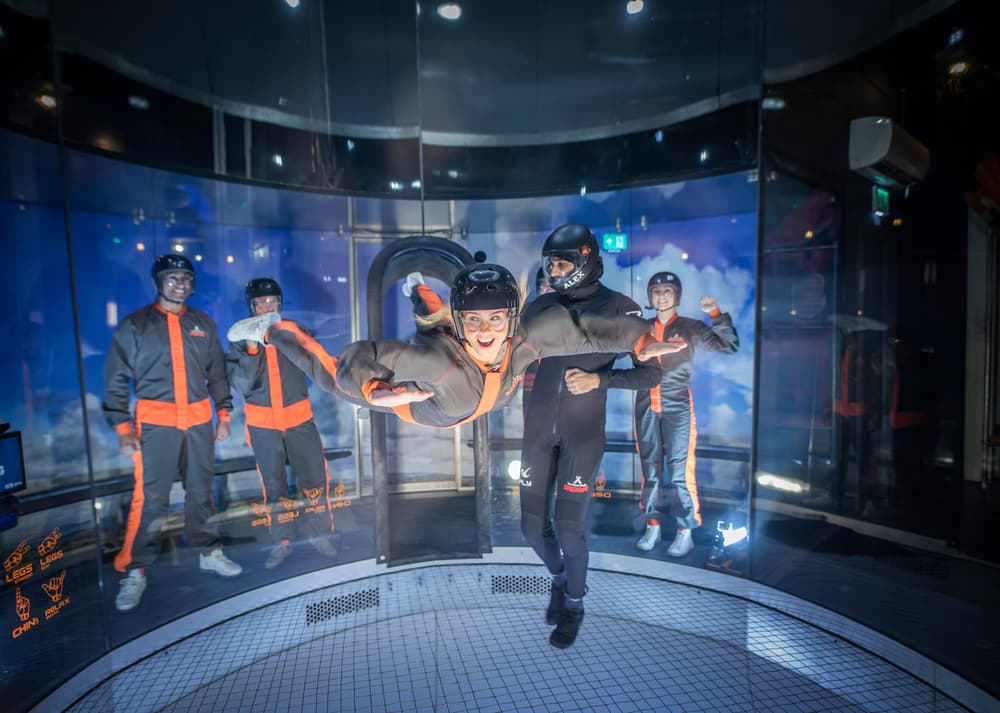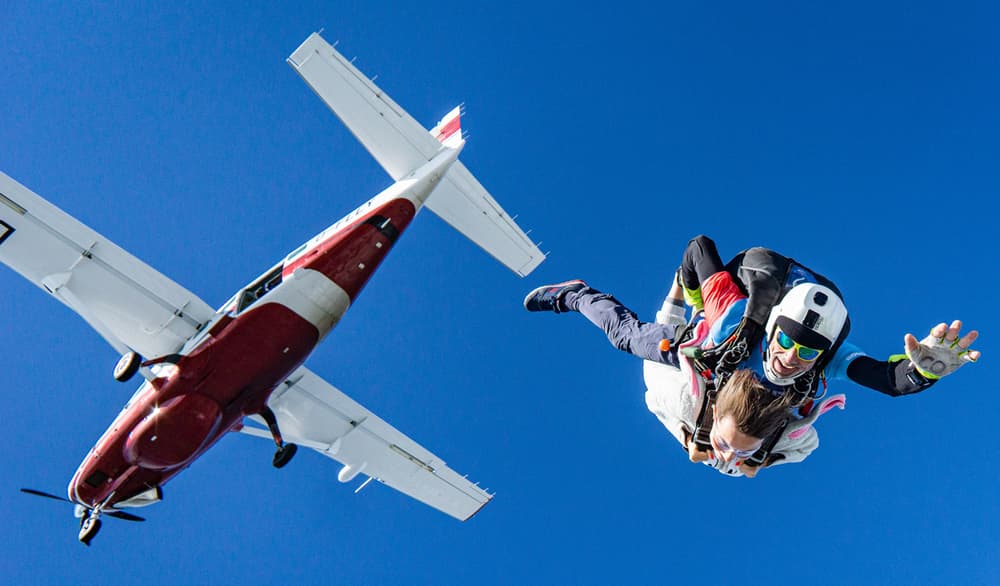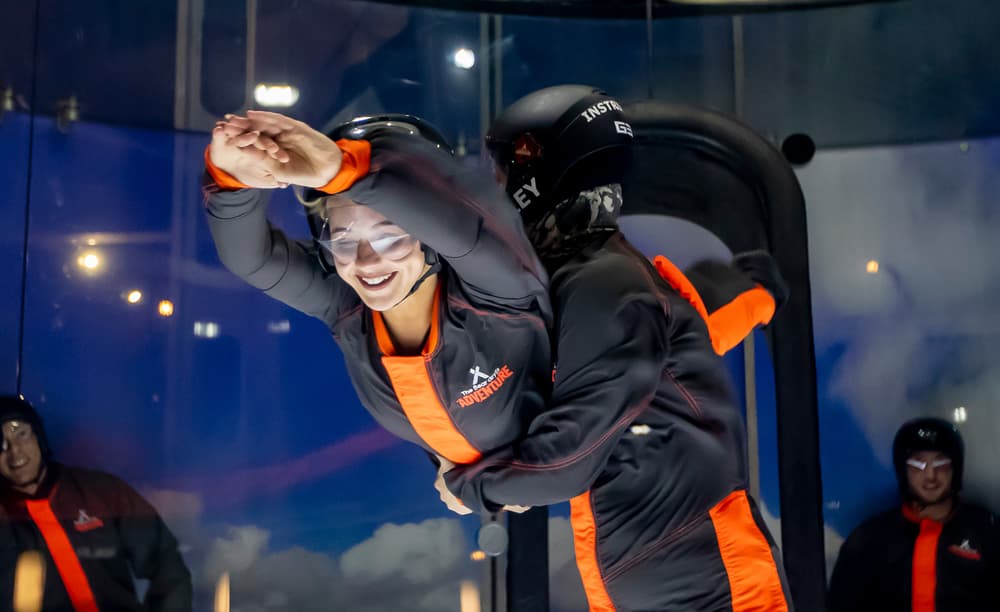
Your Ultimate Guide to Food Festivals in Shropshire
It’s that time of year again—when the evenings stretch a little longer, blue skies start making a regular appearance and food festivals are popping up all around us. If this i...

Indoor skydiving is very popular as who doesn’t want to experience the feeling of free falling without having to climb thousands of feet in the air in an aeroplane! This is the ultimate guide for anyone that loves the thought of skydiving indoors but doesn’t know where to start to take part in this awesome experience!
Let’s get back to basics and look at what indoor skydiving actually is? Allowing your body to fly in a column of wind is the freest way your body can be without having to go to space to experience anti-gravity! It’s the purest form of flight you can take where you can effortlessly control your movements and literally feel the wind in your hair!

Unsurprisingly, the first vertical wind tunnel was built for the military back in 1940 in America. The intention was that the tunnel would enable military scientists to test theories and designs that just wouldn’t work in horizontal conditions.
The tunnel, based in Langley, was very slow and the wind was actually too weak to support a human flier, but it was still the first instance in where body flight revolution could be explored.
The second attempt to build a wind tunnel that could hold human weight was in the late 1970s. An inventor from Quebec, Jean St-Germain, built an indoor wind chamber for his children with the tunnel being the first vertical tunnel for people to fly in.
The chamber had a big propellor underneath the chamber which pulled from a DC-3 aircraft and padded walls. Thank goodness there were pads as the wind created by the propellor didn’t reach from wall to wall, so it was easy to slip off the supporting central column of strongest air and plummet into the bumpers!
Once the world saw St Germain’s creation, there were many other propeller designs created with mobile, semi-permanent and permanent installations. Outdoor wind tunnels of a similar design often made appearances at skydiving drop zones.
The world of indoor skydiving evolved and recirculating tunnels emerged in 2005 with the popularity exploding of tunnels and skydiving indoor growing at a huge rate. In 2015 a 17ft tunnel was created giving it the title of the world’s largest wind tunnel in the world when it opened in December!
As skydiving tunnels are technically wind tunnels engineered to keep a person floating for an extended time period, it gives indoor skydiving an edge over outdoor skydiving as you can manipulate the freefall period. This is because you can then adjust the windspeed to compensate for gravity meaning you can stay afloat longer.
Indoor skydiving consists of three vertical tunnels standing parallel to each other and are connected to air ducts and giant fans that are over 12 feet above. It’s surprising to hear that there’s no fan below to push your body weight but due to not being able to control the airflow, it was decided early on that three vertical columns with two air ducts above equipped with a fan would be a better option.
There are three vertical columns in the wind tunnels, and the two air ducts above are equipped with one fan each. The chamber in the middle is where you feel wind tunneling which is located in the middle of the second column. The fans at the top draw air from the flight chamber and push it aside to the first and third columns. It’s these fans that can draw air at around 30mph. The air pressure is then quadrupled by narrowing the air ducts beneath the flight chamber giving you a terminal velocity of 120mph. The standard tunnels in the UK can reach between 160-180mph.

Although you’d think that the indoor version of skydiving would bare many resemblances to the outdoor version, this is in fact wrong. Whereas indoor skydiving needs a vertical wind tunnel for the controlled vertical wind flow as this simulates the conditions found in freefall, real skydiving involves exiting a plane from 10,000 feet and descending at speeds of 120mph in an uncontrolled environment!
The good thing about indoor skydiving is also the planned nature that it allows you as skydiving is obviously outside, so therefore there is always the possibility of cancellations due to weather or mechanical failures of the plane!
A normal skydive from 13,000 feet lasts between 45-60 seconds whereas indoor skydiving flights last between 60 and 120 seconds, giving you more flying time than a traditional skydive and will feel a lot longer when you’re actually doing it!
It may not seem long, but the experience is intense and mirrors the freefall portion of a skydive from a plane. Multiple flights are often bundled together, so participants can have several turns in the wind tunnel, with brief breaks in between to rest and receive feedback from the instructor. The entire experience, including training, gearing up, and the flights themselves, usually takes about an hour or two, depending on the package purchased.
Indoor skydiving isn’t just fun, it’s amazing! This is because you experience so many feelings when doing it so once it’s completed, it would be hard not to love it!
The physical sensations you get are feeling free, experimenting with the feeling of human body flight manipulating your body forwards, backward, left, right, up, down or even turning and the adrenaline rush!
You’ll also feel like you’ve achieved new goals, potentially becoming a part of an encouraging community if you decide to take it up as a hobby!
It can also have a really positive impact on your mood. Wind tunnel is like exercise so serotonin and other chemicals are released into the brain that are closely associated with feelings of happiness and confidence.
Then don’t also forgot the main achievement…you threw yourself into the unknown giving you an inherent confidence boost that you challenged yourself and a sense of accomplishment that accompanies making it a reality.

Whether you find indoor skydiving scary or not completely depends on the type of person you are! There’s always an element of fear in adrenaline rush activities but how scary depends on a few factors.
How often you subject yourself to high intensity experiences is one reason you may find it scary as if you’re used to subjecting yourself to adrenaline fueled fun then you will be used to the feelings and know how to deal with them beforehand.
However, if you like the quiet life and don’t really put yourself in these kind of situations, these feelings might be quite alien to you and you may not know how to deal with the beating heart and nervous tummy as well.
Despite the thought you might be in a violent wind tunnel, this is the opposite to what you might think. It’s actually gentler than you think and there’s no big jump advised when you actually start the dive!
It’s obviously not risk free as there’s always going to be the potential for the odd bump or scrape, as is the case with anything where free fall is involved! But, on the whole its very safe and there’s a safety instructor with you the whole time advising and guiding you.
You’ll have the necessary safety equipment of a helmet, goggles, and a flight suit which will protect your head and eyes.
They’ll also be an instructor providing important safety assistance and make you stable while floating. They’ll also show you how to stay still, turn, and go up and down while making sure they can help control your body.
In the rare occurrence that someone does get injured it’s most likely that it’s related to a muscle tear or dislocation of a shoulder joint, especially if you have previously dislocated your shoulder, are double jointed or have ligamentous laxity.
Also if you have a heart condition, it is advised that you do not try indoor skydiving. The activity is highly stressful and can increase your chance of a stroke during the flight.
Despite the fact that indoor skydiving is often given as a gift or an experience day gift, it’s not as easy as just turning up and throwing yourself into a wind tunnel!
As the sensation of flying in a column of air is unfamiliar you need to make sure that your spatial awareness is alert as this is the key to developing the skill to fly effortlessly. Also, as with anything in life, the more time spent in a wind tunnel, the better you’ll become at it.

The short answer is like you’re floating on air! You almost feel weightless as you float on a column of air and to begin with the feeling of being out of control can be overwhelming, but once you start to relax and you become stable adapting the solid arched body position that you’re told about before you fly, the sensation of floating is very satisfying!
Indoor skydiving aims to replicate the sensation of freefall without jumping from an aeroplane. You'll feel a continuous rush of air pushing you upwards in a vertical wind tunnel, allowing you to float and manoeuvre with the guidance of an instructor. It's a balance of resistance and freedom, often described as floating on a powerful air column, without the stomach-dropping sensation typically associated with outdoor skydiving.
The maximum weight is 114kg with a maximum height of 6ft 7, with the minimum age 3 years of age or above and there may be a height-to-weight ratio to consider for safety reasons. Some facilities have lower weight limits for children. For height, there is typically no restriction, but participants must fit into the provided flight suits and gear. It is always recommended to check with the specific indoor skydiving location for their exact requirements.
As mentioned above, indoor skydiving is all about learning to control your body in the air flow. By retaining an arched body position and using your arms and legs to control you, you can perform turns and move forwards, backwards, up and down.
The first art you need to master with indoor skydiving is how to enter the wind tunnel. You need to fold your arms across your body then lower yourself through the door, all with the instructor next to you. The more you do this the easier it becomes.
It's paramount that you don’t try and jump when you’re in the wind tunnel as your body shape and position is what determines your movement and if you jump initially, you won’t have the control you need.
In order to get used to the air flow you need to achieve a stable position. This is done by arching your body by pushing forward at the hips. By creating a center of mass at your core means you have the stability but you still have full control of your arms and legs which helps you move.
When you first get into the wind tunnel, you’ll use these first moments to get used to the body position and how it feels with the air pressure on you. As the wind speed will be low you can easily correct your position with guidance from the instructor.
The fundamentals of indoor skydiving are based on aerodynamics as our movements are affected by displacing the air pressure as it hits the body, resulting in the ability to turn.
You start with the stable arched body position which should be held throughout and then to make a turn, you dip your shoulder and arm slightly on the side you want to turn with hands pointing forward. So to turn right, you’d dip your right arm.
As long as you keep your body in the arched position, and the arms and legs are symmetrical you’ll perform a stable turn.
Once you’ve mastered the body positions, you need to learn how to change your fall rate meaning you can fly up and down in the wind tunnel.
To go down and increase your fall rate, you’ll need the stable arched position pushing forward more with your hips. You’ll also bring your arms towards your body, therefore decreasing your surface area and allowing you to fall faster.
To slow down and decrease your fall rate, you’ll relax your hips and cup the air with your chest using your arms and legs to make yourself as big as possible. This will slow you down and mean you can fly up.
Top tips for indoor skydiving:
Indoor skydiving is now that popular that there are places popping up all over big cities like Manchester, Birmingham and close to London.
iFly are the main providers of indoor skydiving in the UK and their indoor skydiving Manchester gives you the chance to try out this thrill in the North of the Country. For indoor skydiving Birmingham, you have iFly with the Bear Grylls experience and for indoor skydiving in London, iFly also have a center in Milton Keynes.
For those of you that love the feeling of falling whilst indoors and want to take it up as a hobby, then you can search for indoor skydiving clubs near me and it will return results for local clubs.
At these clubs, you start by checking in, followed by a brief training session where you learn about body positions and hand signals. After training, you are equipped with a flight suit, helmet, and goggles. There's usually a waiting period before your turn, during which you can watch others fly. Then, accompanied by an instructor, you enter the wind tunnel for your flight experience, where the instructor helps you stabilize and may assist with manoeuvres. After flying, you debrief with the instructor to find out how you can improve in the future.

It’s that time of year again—when the evenings stretch a little longer, blue skies start making a regular appearance and food festivals are popping up all around us. If this i...

When it comes to Father’s Day, socks and a new tie just don’t cut it anymore. If your dad is a sports enthusiast, it’s time to step up your gift game with something he’ll neve...

London is a city filled with so much excitement and opportunity. From the buzzing nightlife of Soho to the creative energy of Camden, there’s no shortage of things for couples...

If you're looking into driving experiences for youngsters, you've probably come across terms like 'Junior Driving Experience' and 'Young Driver Experience.' While they might s...
Why our customers love us
Change to an experience that suits your current mood
eVouchers are sent directly to your email inbox within seconds
Sign up to be the first to hear about fantastic offers, exclusive newsletter-only discounts & competitions.